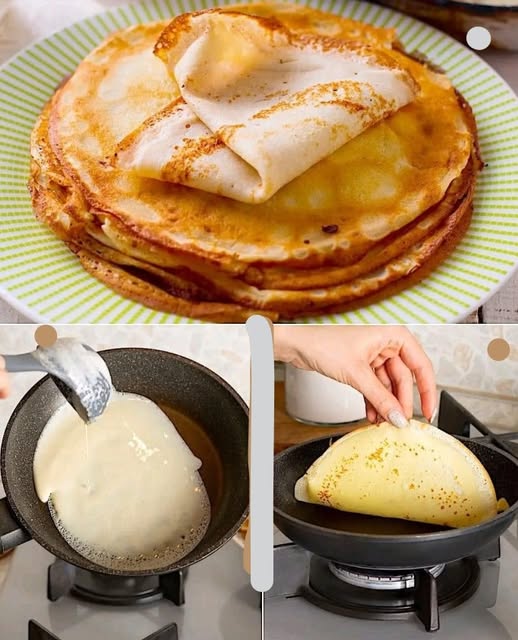Crêpes are a classic French treat, thin and delicate pancakes that can be enjoyed for breakfast, brunch, dessert, or even as a savory meal. Making crêpes at home is simpler than it seems, and the results are tender, flavorful, and versatile. This recipe produces light, smooth crêpes that you can fill with sweet or savory ingredients.
The key to perfect crêpes lies in the batter. By gradually incorporating the milk into the flour and eggs, and letting the batter rest for at least an hour, you ensure a smooth mixture without lumps. Resting allows the flour to fully absorb the liquid, resulting in a tender, flexible crêpe that cooks evenly.
Ingredients
- 3 eggs
- ½ liter of milk
- ½ teaspoon salt
- 250 grams of flour
- 50–55 grams of butter
Preparation Instructions
Begin by combining the flour and salt in a large bowl. Create a small well in the center, similar to how pasta dough is prepared. In a separate container, lightly beat the eggs to avoid any shell fragments and pour them into the well. Melt the butter in the microwave for a few seconds, then add it to the eggs. Mix gently with a whisk until the ingredients are well incorporated.
Gradually pour the milk into the mixture, stirring continuously to avoid lumps. Once fully combined, pass the batter through a fine sieve using a spatula. This ensures any remaining lumps are removed, leaving a smooth and velvety batter. Cover the batter and let it rest for at least one hour.
After resting, heat a medium or large non-stick pan over low heat and lightly grease with butter. Using a ladle, pour a portion of the batter into the pan and spread it evenly by tilting and rotating the pan. When bubbles form on the surface and the edges start to lift, check if the crêpe is golden underneath. Flip carefully and cook the other side for about 45 seconds. Repeat this process until all the batter is used.
Tips for Perfect Crêpes
- Always rest the batter for at least one hour; this improves texture and prevents tearing.
- Use a non-stick pan and minimal butter to avoid sticking. Wipe excess butter with paper towels if needed.
- Pour the batter slowly and spread it evenly to control thickness; thinner crêpes are more delicate and fold easily.
- Adjust heat carefully; too high can burn the crêpes, while too low may prevent proper browning.
Serving Suggestions
Crêpes are incredibly versatile:
- Sweet: Fill with Nutella, fresh berries, whipped cream, jam, or caramel sauce. Dust with powdered sugar or drizzle with chocolate for an indulgent treat.
- Savory: Fill with ham, cheese, sautéed mushrooms, spinach, or smoked salmon. Add a touch of béchamel or cream for richness.
- Rolled or Folded: Fold crêpes into triangles, rolls, or envelopes to create elegant presentations.
Crêpes can also be stacked with layers of filling in between for a crêpe cake or used to create a variety of appetizers.
Storage
- Uncooked batter can be stored in the refrigerator for up to 24 hours. Stir gently before using.
- Cooked crêpes can be stacked with parchment paper in between and refrigerated for up to 3 days.
- To reheat, warm gently in a dry skillet or microwave for a few seconds until soft and pliable.
Variations
- Substitute half of the all-purpose flour with whole wheat flour for a nuttier flavor and more fiber.
- Add a teaspoon of vanilla or a tablespoon of sugar for sweeter crêpes.
- For a dairy-free version, replace milk with almond, oat, or soy milk and use plant-based butter.
Conclusion
Homemade crêpes are a versatile and elegant dish that can be enjoyed any time of the day. With a few simple ingredients and proper technique, you can create tender, flavorful crêpes that are perfect for both sweet and savory fillings. They are fun to make, customizable, and sure to impress family and friends. Whether rolled, folded, or stacked, these crêpes are a delightful addition to any meal.
